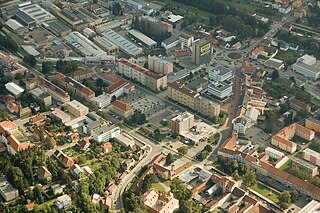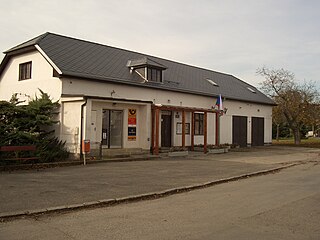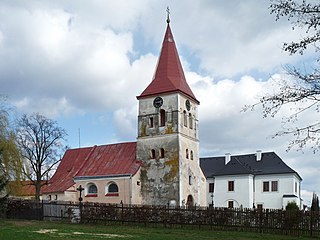Related Research Articles

Prachatice is a town in the South Bohemian Region of the Czech Republic. It has about 11,000 inhabitants. The historic town centre is well preserved and is protected by law as an urban monument reservation.

Blansko is a town in the South Moravian Region of the Czech Republic. It has about 20,000 inhabitants. It lies on the Svitava River on the border of the Moravian Karst. It is mainly an industrial town.

Nýrsko is a town in Klatovy District in the Plzeň Region of the Czech Republic. It has about 5,100 inhabitants.

Havířov is a city in Karviná District in the Moravian-Silesian Region of the Czech Republic. It has about 70,000 inhabitants, making it the second-largest city in the region. Havířov was founded in 1955 and is the youngest Czech city. It is an industrial city, historically associated with hard coal mining in the region.

Dolní Benešov is a town in Opava District in the Moravian-Silesian Region of the Czech Republic. It has about 3,900 inhabitants. It is part of the historical Hlučín Region.

Dolní Němčí is a municipality and village in Uherské Hradiště District in the Zlín Region of the Czech Republic. It has about 2,900 inhabitants.

Horní Suchá is a municipality and village in the Karviná District in the Moravian-Silesian Region of the Czech Republic. It has about 4,400 inhabitants. The municipality has a significant Polish minority.

Obec is the Czech and Slovak word for a municipality. The literal meaning of the word is "commune" or "community". It is the smallest administrative unit that is governed by elected representatives. Cities and towns are also municipalities.

Vlachovo Březí is a town in Prachatice District in the South Bohemian Region of the Czech Republic. It has about 1,700 inhabitants. The historic town centre is well preserved and is protected by law as an urban monument zone.

Frýdek-Místek District is a district in the Moravian-Silesian Region of the Czech Republic. Its capital is the city of Frýdek-Místek.

Komorní Lhotka is a municipality and village in Frýdek-Místek District in the Moravian-Silesian Region of the Czech Republic. It has about 1,500 inhabitants. The municipality has a significant Polish minority. The folk architecture in the village is well preserved and is protected by law as a village monument zone.

Přerov District is a district in the Olomouc Region of the Czech Republic. Its capital is the city of Přerov.

Řitka is a municipality and village in Prague-West District in the Central Bohemian Region of the Czech Republic. It has about 1,400 inhabitants.

Římov is a municipality and village in České Budějovice District in the South Bohemian Region of the Czech Republic. It has about 1,000 inhabitants.

Dolní Břežany is a municipality and village in Prague-West District in the Central Bohemian Region of the Czech Republic. It has about 4,700 inhabitants.

Ruda nad Moravou is a municipality and village in Šumperk District in the Olomouc Region of the Czech Republic. It has about 2,600 inhabitants.

Pluhův Žďár is a municipality and village in Jindřichův Hradec District in the South Bohemian Region of the Czech Republic. It has about 600 inhabitants. The municipality is known for the Červená Lhota Castle.

Maleč is a municipality and village in Havlíčkův Brod District in the Vysočina Region of the Czech Republic. It has about 600 inhabitants.

Dolní Lhota is a municipality and village in Zlín District in the Zlín Region of the Czech Republic. It has about 700 inhabitants.

Dolní Lhota is a municipality and village in Ostrava-City District in the Moravian-Silesian Region of the Czech Republic. It has about 1,500 inhabitants.
References
- 1 2 "Nejstarší Lhota je v Pardubickém kraji. Dnes už se ale jmenuje jinak" (in Czech). Deník.cz. 2020-08-27. Retrieved 2023-08-31.
- ↑ "Population of Municipalities – 1 January 2023". Czech Statistical Office. 2023-05-23.
- 1 2 "Název obcí Lhota". Ptejte se knihovny (in Czech). National Library of the Czech Republic. 2008-01-23. Retrieved 2023-08-31.